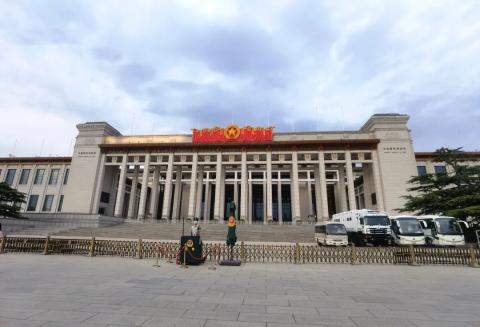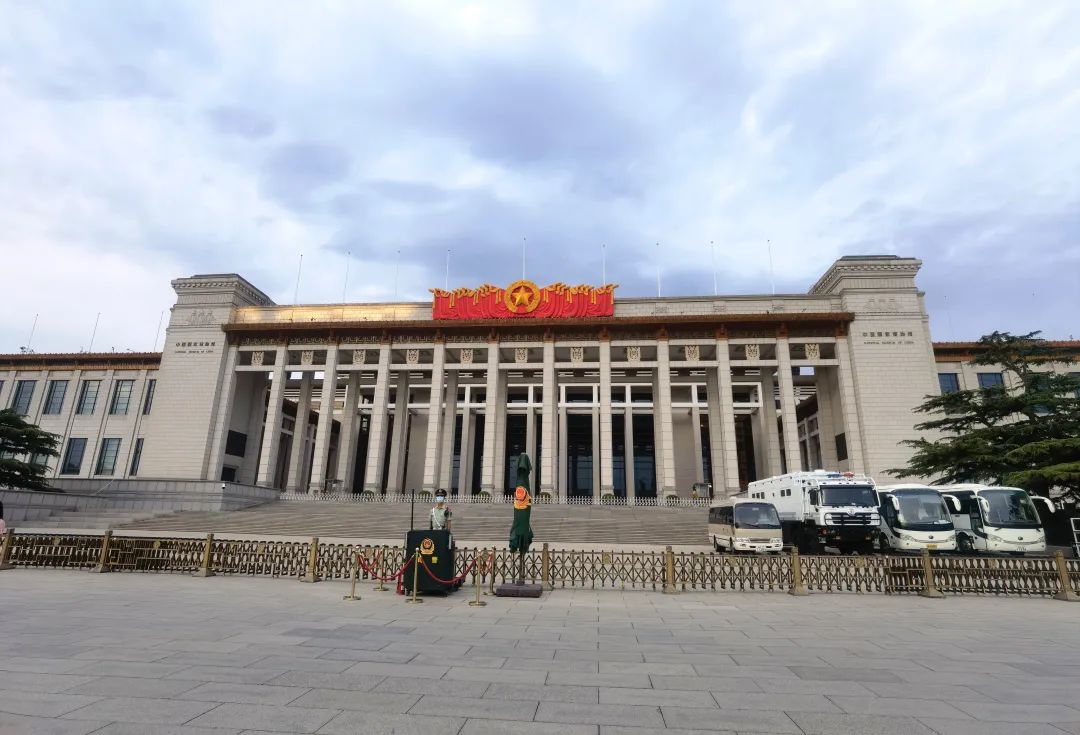
Day5 National Museum of China + Temple of Heaven Park Chapter
On the fifth day of our trip to Beijing, our plan was to visit the National Museum of China and the Temple of Heaven Park.
- National Museum of China
The National Museum of China is located in the center of Beijing Tiananmen Square On the east side, symmetrically located with the Great Hall of the People from east to west, it is a comprehensive museum that emphasizes both history and art and integrates collection, exhibition, research, archaeology, public education, and cultural exchange.

The National Museum of China enters through the back door and exits through the main entrance.
It's very big inside. If you look at every pavilion carefully, there won't be enough time in one day, so we chose some of the pavilions that we were more interested in to visit.


Ancient China on the underground floor, don’t miss this exhibition! This museum is really full of national treasures, many of which we read in history books when we were children, such as the Four-Yang Fangzun, drumming and rapping figurines, jade dragons, jade clothes with golden threads, etc. We can see them in real form here. It’s really amazing. Feast your eyes! Breathtaking!


Does this Jade Dragon look familiar? This prototype has been used in many places.


There were many arrows on this bronze turtle. The two little ones said that this turtle was so pitiful. . .

Oracle

The famous Siyang Fangzun!

Sanxingdui mask

Bronze sword of King Wu Fu Chai


Gold thread jade clothing


Drumming and rapping figurines



I read Dream of Red Mansions and some classical novels, and there are always very detailed descriptions of women’s clothing and the decorations in the house. But just by reading the text, I can’t imagine the specific styles in many places, so I like to look at these hairpins. Hairpin, Bu Yao, etc., what is jadeite, what is enamel, after reading these, you can imagine what the woman's dress looks like when you read the book; you also like to see the decorations, such as flower pattern hollow jade fragrance, Pastel hollowed-out revolving vases, rouge water-glazed bowls, turquoise-green glazed plum vases, etc. In this way, you can roughly imagine what the decorations in the room look like.
Although you can search for pictures online, there is still a big difference between looking at pictures and looking at the real thing. The texture is different. If you want to see these treasures, you can see many of them at once in the museum.








Empress Xiaoduan's phoenix crown in the Ming Dynasty

Emperor's treasure

I read about the red ground woven gold cloud dragon satin in the book, and then I really understood it after looking at this piece of fabric.


In short, this exhibition hall of ancient China is really not to be missed. It is a treasure and a visual feast!
After being optimistic about this museum, we also visited several small exhibition halls.
Exhibition of Ancient Chinese Coins




Exhibition of Ancient Chinese Bronze Mirrors - A Thousand Years in the Mirror



Two little ones are playing with the bronze mirror puzzle.

Ancient Chinese Jade Art Exhibition





Exhibition of ancient Chinese calligraphy and painting





Portrait Exhibition of the Ming and Qing Dynasties - Wonderful Harmony of Divine Forms



Xin Chou Year of the Ox Spring Festival Cultural Exhibition - Everything goes well for the Ox






There were some other exhibitions that we didn't see, and it was almost 2 o'clock when we came out, so the National Museum can arrange a day. (I really wanted to stay for a day, but I was worried that the children wouldn’t be able to stay for that long, so I had to make a choice and watch the exhibition.)
Coming out of the main entrance, the blue sky, white clouds, and sunshine are so bright!

Tips:
1. Tickets are free.
2. There are people selling simple meals inside, which can satisfy your stomach.
3. The air conditioning is sufficient, so it’s best to bring a jacket. Generally speaking, the air conditioning in museums is fully turned on. I once went to a museum in the summer and it got colder and colder as I walked around. I ended up catching a cold. I usually bring a thin jacket when I go to large museums.
- Tiantan Park
The Temple of Heaven is a sacrificial building complex where emperors of the Ming and Qing dynasties offered sacrifices to heaven and prayed for grain. It was built in the 18th year of Yongle of the Ming Dynasty (1420). Although most of the existing buildings were built in the Qing Dynasty, their layout was still left over after the Jiajing establishment of the Ming Dynasty. The area of the altar is 2.73 million square meters. The Temple of Heaven is the general name for the two altars of Qigu and Circular Mound. It is surrounded by two walls and divides the altar area into two parts: the inner and outer altars. The south is square and the north is round.
The main buildings of the Temple of Heaven are the inner altar, with 圜 mound, Imperial Vaultyu in the south, and Prayer Hall and Huangqian Hall in the north. There is a road running through the north and south. The corridor, Danbi Bridge , connects the two groups of buildings. There are also landscapes such as the promenade, the Seven-Star Stone, and the Kowloon Cypress. The main existing ancient building in the outer altar is the Divine Music Department, which was a place for practicing rituals and music during the Ming and Qing Dynasties.

Our route was to enter from the west gate, walk along a large road to the inner altar, visit the Hall of Prayer for Good Harvests and other buildings in the north, and then visit the Circular Temple in the south. Qiu and other buildings, and finally exit from the south gate.
Entering from the west gate, such a tree-lined avenue is also very impressive!



This row of ancient trees, with a history of five or six hundred years, really makes me feel flattered! Generally speaking, a tree that is five or six hundred years old is very rare, but here they are displayed in a row. It really has a lot of heritage!

Go past this corridor and buy tickets for the Inner Altar Hall of Prayer for Good Harvests and the Circular Mound.

This is the Gate of Prayer for Good Harvests, the main entrance of the courtyard of the Hall of Prayer for Good Harvests. It is the highest-level door system in ancient China and an original thing from the early Ming Dynasty.

The Hall of Prayer for Good Harvests was built in the 18th year of Yongle in the Ming Dynasty (1420). It was originally called the "Great Sacrifice Hall" and was a rectangular hall used to worship heaven and earth. In the 24th year of Jiajing reign (1545), it was changed to a three-eaves round hall. The roof of the hall was covered with three-color glazed glass, namely upper green, middle yellow and lower green, which symbolizes heaven, earth and all things, and was renamed "Daxiang Hall". In the 16th year of Qianlong's reign in the Qing Dynasty (1751), the three-color glazed tiles were replaced with a unified blue-tiled golden roof, which was named "Prayer for Good Harvests". This is the only remaining example of ancient Mingtang-style architecture.


If you continue walking forward from the Hall of Prayer for Good Harvests, you will see the Huangqian Hall. The Huangqian Hall is a temple dedicated to worshiping the "Emperor God" and the emperor's ancestors. Its plaque is written by Emperor Jiajing of the Ming Dynasty, Zhu Houcong.




After that, we came to the building complex to the south.
Huangqiongyu is a place where the Circular Mound Altar is used to worship gods.


The first three stone slabs on the corridor in front of the Imperial Vault Hall are the "Three-tone Stones". When you stand on the first stone slab and give a high-five, you can hear only one echo; when you stand on the second stone slab and you give a high-five, you can hear two echoes; when you stand on the third stone slab and you give a high-five, you hear two echoes. Three echoes in a row. The two little ones also specially talked and high-fived on this stone. I don’t know if it was because there were so many people and noisy people around. I didn’t hear an obvious echo, but the two little ones didn’t know if it was a psychological effect. They said they heard it. echo.

The circular wall around the Imperial Qiongyu courtyard is about 3.72 meters high and 0.9 meters thick. The wall is made of Shandong Linqing bricks with ground joints and a blue glazed tube tile roof. This is the famous "Echo Wall ".

Yuanqiu is the place where the emperor held the Winter Solstice ceremony to worship the sky.

The Circular Mound Altar is divided into three levels, with nine steps on each side of each level. Each floor is surrounded by finely carved white marble railings. The numbers on the railings are all nine or multiples of nine, symbolizing the number of "heavens".



The upper mesa of the circular mound is surrounded by nine rings of mesa stones, and the central circular stone slab is called the "Tianxin Stone". With the Tianxin Stone as the center, the first circle of stone slabs is nine, the second circle is eighteen stone slabs, and then the number of stone slabs is increased by nine, until ninety-nine and eighty-one, which means "nine heavens". People stand in the heart of the sky. When Shi Shang spoke, his voice was particularly rich and resonant.
So the two little ones also wanted to give it a try. They both felt that they were standing on the Tianxin Stone and speaking, and their voices were indeed louder!

After visiting Yuanqiu, the loudspeaker in the park started to announce that it was time to leave the park, so we went out through the south gate.
We also had a gathering with friends for dinner in the evening. It was a full day for us and full of rewards!
Tips:
1. There is no bathroom in the courtyard of the Hall of Prayer for Good Harvests, nor can I see it in the Circular Qiu Altar, so it is best to go to the bathroom before entering the inner altar. Don’t ask me how I knew this. We had just bought our tickets and entered the courtyard of the Hall of Prayer for Good Harvests. When we arrived at the Prayer for Good Harvest Gate, my brother said he wanted to use the bathroom, so he asked the staff where there was one. The staff said there wasn’t one inside and asked me to go to the west gate (Qi Harvest) quickly. There was the nearest bathroom outside the entrance (the west gate of the temple courtyard), so I went out and in again. Fortunately, there was no need to buy a new ticket for a reason.
2. Tickets to enter the outer altar are 15 yuan/person, and tickets to the inner altar are 20 yuan/person. You can also buy a combined ticket for 34 yuan/person.
